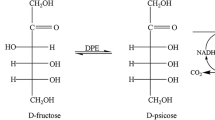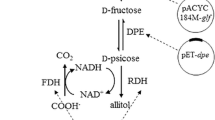Abstract
A recombinant oxidation/reduction cycle for the conversion of D-fructose to D-mannitol was established in resting cells of Corynebacterium glutamicum. Whole cells were used as biocatalysts, supplied with 250 mM sodium formate and 500 mM D-fructose at pH 6.5. The mannitol dehydrogenase gene (mdh) from Leuconostoc pseudomesenteroides was overexpressed in strain C. glutamicum ATCC 13032. To ensure sufficient cofactor [nicotinamide adenine dinucleotide (reduced form, NADH)] supply, the fdh gene encoding formate dehydrogenase from Mycobacterium vaccae N10 was coexpressed. The recombinant C. glutamicum cells produced D-mannitol at a constant production rate of 0.22 g (g cdw)−1 h−1. Expression of the glucose/fructose facilitator gene glf from Zymomonas mobilis in C. glutamicum led to a 5.5-fold increased productivity of 1.25 g (g cdw)−1 h−1, yielding 87 g l−1D-mannitol from 93.7 g l−1D-fructose. Determination of intracellular NAD(H) concentration during biotransformation showed a constant NAD(H) pool size and a NADH/NAD+ ratio of approximately 1. In repetitive fed-batch biotransformation, 285 g l−1D-mannitol over a time period of 96 h with an average productivity of 1.0 g (g cdw)−1 h−1 was formed. These results show that C. glutamicum is a favorable biocatalyst for long-term biotransformation with resting cells.




Similar content being viewed by others
References
Agius SC, Rasmusson AG, Møller IM (2001) NAD(P) turnover in plant mitochondria. Aust J Plant Physiol 28:461–470
Barnell WO, Yi KC, Conway T (1990) Sequence and genetic organization of a Zymomonas mobilis gene cluster that encodes several enzymes of glucose metabolism. J Bacteriol 172:7227–7240
Bäumchen C, Knoll A, Husemann B, Seletzky J, Maier B, Dietrich C, Amoabediny G, Büchs J (2007) Effect of elevated dissolved carbon dioxide concentrations on growth of Corynebacterium glutamicum on D-glucose and L-lactate. J Biotechnol 128:868–874
Bernofsky C, Swan M (1973) An improved cycling assay for nicotinamide adenine dinucleotide. Anal Biochem 53:452–458
Bradford MM (1976) A rapid and sensitive method for the quantitation of microgram quantities of protein utilizing the principle of protein-dye binding. Anal Biochem 72:248–254
Dominguez H, Lindley ND (1996) Complete sucrose metabolism requires fructose phosphotransferase activity in Corynebacterium glutamicum to ensure phosphorylation of liberated fructose. Appl Environ Microbiol 62(10):3878–3880
Eggeling L, Bott M (2005) Handbook of Corynebacterium glutamicum. Eggeling L, Bott M (eds). CRC, Boca Raton, FL, USA
Eikmanns BJ, Kleinertz E, Liebl W, Sahm H (1991) A family of Corynebacterium glutamicum/Escherichia coli shuttle vectors for cloning, controlled gene expression, and promoter probing. Gene 102:93–98
Fudou R, Jojima Y, Seto A, Yamada K, Kimura E, Nakamatsu T, Hiraishi A, Yamanaka S (2002) Corynebacterium efficiens sp. nov., a glutamic acid-producing species from soil and vegetables. Int J Syst Evol Microbiol 52:1127–1131
Galkin A, Kulakova L, Tishkov V, Esaki N, Soda K (1995) Cloning of formate dehydrogenase gene from a methanol-utilizing bacterium Mycobacterium vaccae N10. Appl Microbiol Biotechnol 44:479–483
Grant SG, Jessee J, Bloom FR, Hanahan D (1990) Differential plasmid rescue from transgenic mouse DNAs into Escherichia coli methylation-restriction mutants. Proc Natl Acad Sci USA 87:4645–4649
Hahn G, Kaup B, Bringer-Meyer S, Sahm H (2003) A zinc-containing mannitol-2-dehydrogenase from Leuconostoc pseudomesenteroides ATCC 12291: purification of the enzyme and cloning of the gene. Arch Microbiol 179:101–107
Helanto M, Aarnikunnas J, von Weymarn N, Airaksinen U, Palva A, Leisola M (2005) Improved mannitol production by a random mutant of Leuconostoc pseudomesenteroides. J Biotechnol 116:283–294
Hoischen C, Krämer R (1990) Membrane alteration is necessary but not sufficient for effective glutamate secretion in Corynebacterium glutamicum. J Bacteriol 172(6):3409–3416
Kataoka M, Yamamoto K, Kawabata H, Wada M, Kita K, Yanase H, Shimizu S (1999) Stereoselective reduction of ethyl 4-chloro-3-oxobutanoate by Escherichia coli transformant cells coexpressing the aldehyde reductase and glucose dehydrogenase genes. Appl Microbiol Biotechnol 51:486–490
Kaup B (2004) Gewinnung von D-mannitol mit rekombinanten Escherichia coli Stämmen. Dissertation, Forschungszentrum Jülich GmbH, Germany
Kaup B, Bringer-Meyer S, Sahm H (2004) Metabolic engineering of Escherichia coli: construction of an efficient biocatalyst for D-mannitol formation in a whole-cell biotransformation. Appl Microbiol Biotechnol 64:333–339
Kaup B, Bringer-Meyer S, Sahm H (2005) D-Mannitol formation from D-glucose in a whole-cell biotransformation with recombinant Escherichia coli. Appl Microbiol Biotechnol 69:397–403
Kizaki N, Yasohara Y, Hasegawa J, Wada M, Kataoka M, Shimizu S (2001) Synthesis of optically pure ethyl (S)-4-chloro-3-hydroxybutanoate by Escherichia coli transformant cells coexpressing the carbonyl reductase and glucose dehydrogenase genes. Appl Microbiol Biotechnol 55:590–595
Moon MW, Kim HJ, Oh TK, Shin CS, Lee JS, Kim SJ, Lee JK (2005) Analyses of enzyme II gene mutants for sugar transport and heterologous expression of fructokinase gene in Corynebacterium glutamicum ATCC 13032. FEMS Microbiol Lett 244:259–266
Moritz BM (2000) Untersuchungen zur Regulation des Pentosephosphatweges in Corynebacterium glutamicum. Dissertation, University Düsseldorf, Germany
Parker C, Barnell WO, Snoep JL, Ingram LO, Conway T (1995) Characterization of the Zymomonas mobilis glucose facilitator gene product (glf) in recombinant Escherichia coli: examination of transport mechanism, kinetics and the role of glucokinase in glucose transport. Mol Microbiol 15:759–802
Sahm H, Eggeling L, de Graaf AA (2000) Pathway analysis and metabolic engineering in Corynebacterium glutamicum. Biol Chem 381:899–910
Sambrook J, Russell DW (2000) Molecular cloning. A laboratory manual, 3rd edn. Cold Spring Harbor Laboratory Press, Cold Spring Harbor, NY
San K-Y, Bennet GN, Berríos-Rivera SJ, Vadali RV, Yang Y-T, Horton E, Rudolph FB, Sariyar B, Blackwood K (2002) Metabolic engineering through cofactor manipulation and its effects on metabolic flux redistribution in Escherichia coli. Metab Eng 4:182–192
Schiweck H, Bär A, Vogel R, Schwarz E, Kunz M (2002) Sugar alcohols. In: Ullmann’s Encyclopedia of Industrial Chemistry. Wiley–VCH–Verlag, Weinheim
Schütte H, Flossdorf J, Sahm H, Kula MR (1976) Purification and properties of formaldehyde dehydrogenase and formate dehydrogenase from Candida boidinii. Eur J Biochem 62:151–160
Schwarz E (1994) Sugar alcohols: mannitol. Sugar alcohols. In: Elvers B, Hawkins S, Russey W (eds) Ullmann’s encyclopedia of industrial chemistry, 5th edn, vol. A25. Wiley–VCH–Verlag, Weinheim, pp 423–426
Soetaert W, Buchholz K, Vandamme EJ (1995) Production of D-mannitol and D-lactic acid by fermentation with Leuconostoc mesenteroides. Agro Food Ind Hi Technol 6:41–44
Soetaert W, Vanhooren PT, Vandamme EJ (1999) Production of mannitol by fermentation. Methods Biotechnol 10:261–275
Strelkov S, von Elstermann M, Schomburg D (2004) Comprehensive analysis of metabolites in Corynebacterium glutamicum by gas chromatography/mass spectrometry. Biol Chem 385(9):853–861
Tauch A, Kirchner O, Löffler B, Götker S, Pühler A, Kalinowski J (2002) Efficient electrotransformation of Corynebacterium diphtheriae with a mini-replicon derived from the Corynebacterium glutamicum plasmid pGA1. Curr Microbiol 45:362–367
von Weymarn N (2002) Process development for mannitol production by lactic acid bacteria. Dissertation, Helsinki University of Technology, Finland
von Weymarn N, Hujanen M, Leisola M (2002a) Production of D-mannitol by heterofermentative lactic acid bacteria. Process Biochem 37:1207–1213
von Weymarn N, Kiviharju K, Leisola M (2002b) High-level production of D-mannitol with membrane cell-recycle bioreactor. J Ind Microbiol Biotechnol 29:44–49
Walton AZ, Stewart JD (2004) Understanding and improving NADPH-dependent reactions by nongrowing Escherichia coli cells. Biotechnol Prog 20:403–411
Weisser P, Krämer R, Sahm H, Sprenger GA (1995) Functional expression of the glucose transporter of Zymomonas mobilis leads to restoration of glucose and fructose uptake in Escherichia coli mutants and provides evidence for its facilitator action. J Bacteriol 177:3351–3354
Wendisch V (1997) Physiologische und NMR-spektroskopische Untersuchungen zur in vivo-Aktivität zentraler Stoffwechselwege im Wildstamm und in rekombinanten Stämmen von Corynebacterium glutamicum. Dissertation, Forschungszentrum Jülich GmbH, Germany
Yamamoto H, Matsuyama A, Kobayashi Y (2003) Synthesis of ethyl (S)-4-chloro-3-hydroxybutanoate using fabG-homologues. Appl Microbiol Biotechnol 61:133–139
Acknowledgment
We thank Nordzucker AG (Braunschweig, Germany) for financial support.
Author information
Authors and Affiliations
Corresponding author
Additional information
Dedicated to Prof. Hermann Sahm on the occasion of his 65th birthday.
Rights and permissions
About this article
Cite this article
Bäumchen, C., Bringer-Meyer, S. Expression of glf Z.m.increases D-mannitol formation in whole cell biotransformation with resting cells of Corynebacterium glutamicum . Appl Microbiol Biotechnol 76, 545–552 (2007). https://doi.org/10.1007/s00253-007-0987-8
Received:
Revised:
Accepted:
Published:
Issue Date:
DOI: https://doi.org/10.1007/s00253-007-0987-8




